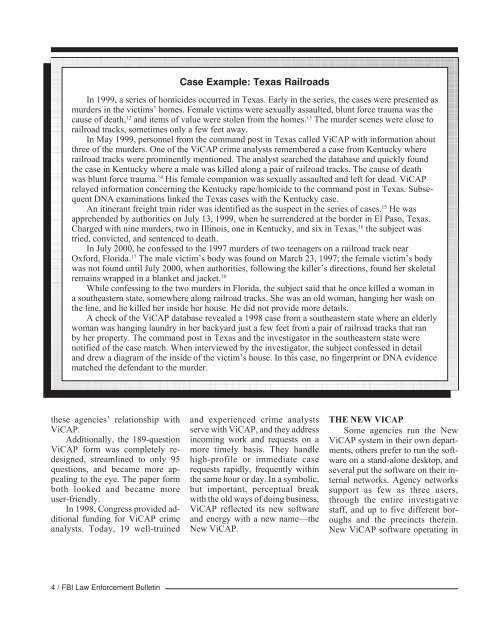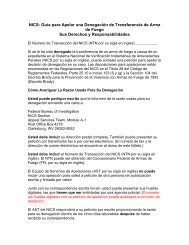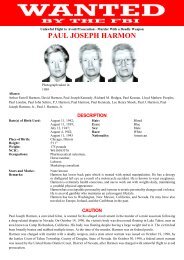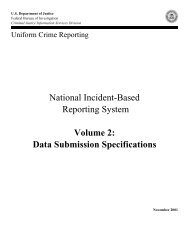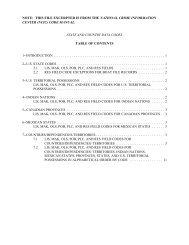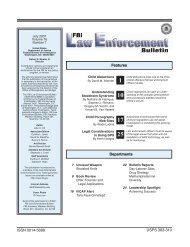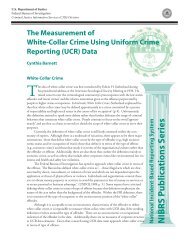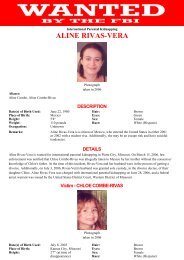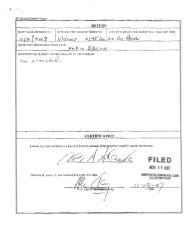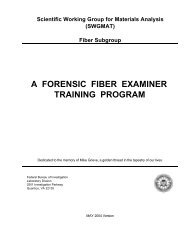F B I Law Enforcement Bulletin - June 2003 Issue
F B I Law Enforcement Bulletin - June 2003 Issue
F B I Law Enforcement Bulletin - June 2003 Issue
Create successful ePaper yourself
Turn your PDF publications into a flip-book with our unique Google optimized e-Paper software.
these agencies’ relationship with<br />
ViCAP.<br />
Additionally, the 189-question<br />
ViCAP form was completely redesigned,<br />
streamlined to only 95<br />
questions, and became more appealing<br />
to the eye. The paper form<br />
both looked and became more<br />
user-friendly.<br />
In 1998, Congress provided additional<br />
funding for ViCAP crime<br />
analysts. Today, 19 well-trained<br />
4 / FBI <strong>Law</strong> <strong>Enforcement</strong> <strong>Bulletin</strong><br />
Case Example: Texas Railroads<br />
In 1999, a series of homicides occurred in Texas. Early in the series, the cases were presented as<br />
murders in the victims’ homes. Female victims were sexually assaulted, blunt force trauma was the<br />
cause of death, 12 and items of value were stolen from the homes. 13 The murder scenes were close to<br />
railroad tracks, sometimes only a few feet away.<br />
In May 1999, personnel from the command post in Texas called ViCAP with information about<br />
three of the murders. One of the ViCAP crime analysts remembered a case from Kentucky where<br />
railroad tracks were prominently mentioned. The analyst searched the database and quickly found<br />
the case in Kentucky where a male was killed along a pair of railroad tracks. The cause of death<br />
was blunt force trauma. 14 His female companion was sexually assaulted and left for dead. ViCAP<br />
relayed information concerning the Kentucky rape/homicide to the command post in Texas. Subsequent<br />
DNA examinations linked the Texas cases with the Kentucky case.<br />
An itinerant freight train rider was identified as the suspect in the series of cases. 15 He was<br />
apprehended by authorities on July 13, 1999, when he surrendered at the border in El Paso, Texas.<br />
Charged with nine murders, two in Illinois, one in Kentucky, and six in Texas, 16 the subject was<br />
tried, convicted, and sentenced to death.<br />
In July 2000, he confessed to the 1997 murders of two teenagers on a railroad track near<br />
Oxford, Florida. 17 The male victim’s body was found on March 23, 1997; the female victim’s body<br />
was not found until July 2000, when authorities, following the killer’s directions, found her skeletal<br />
remains wrapped in a blanket and jacket. 18<br />
While confessing to the two murders in Florida, the subject said that he once killed a woman in<br />
a southeastern state, somewhere along railroad tracks. She was an old woman, hanging her wash on<br />
the line, and he killed her inside her house. He did not provide more details.<br />
A check of the ViCAP database revealed a 1998 case from a southeastern state where an elderly<br />
woman was hanging laundry in her backyard just a few feet from a pair of railroad tracks that ran<br />
by her property. The command post in Texas and the investigator in the southeastern state were<br />
notified of the case match. When interviewed by the investigator, the subject confessed in detail<br />
and drew a diagram of the inside of the victim’s house. In this case, no fingerprint or DNA evidence<br />
matched the defendant to the murder.<br />
and experienced crime analysts<br />
serve with ViCAP, and they address<br />
incoming work and requests on a<br />
more timely basis. They handle<br />
high-profile or immediate case<br />
requests rapidly, frequently within<br />
the same hour or day. In a symbolic,<br />
but important, perceptual break<br />
with the old ways of doing business,<br />
ViCAP reflected its new software<br />
and energy with a new name—the<br />
New ViCAP.<br />
THE NEW VICAP<br />
Some agencies run the New<br />
ViCAP system in their own departments,<br />
others prefer to run the software<br />
on a stand-alone desktop, and<br />
several put the software on their internal<br />
networks. Agency networks<br />
support as few as three users,<br />
through the entire investigative<br />
staff, and up to five different boroughs<br />
and the precincts therein.<br />
New ViCAP software operating in


